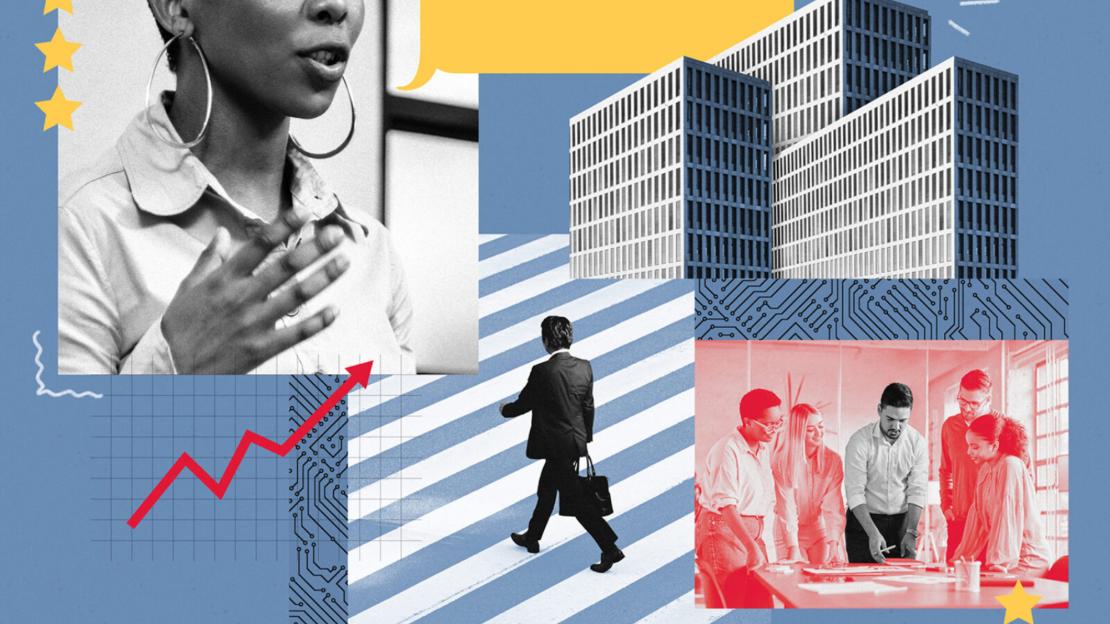Jumping on a zoom call from his hotel room at the COP28 conference in Dubai, cleantech executive Phil De Luna marvels at the carnival-like atmosphere that has swept over the United Arab Emirates city. “It’s almost like a music festival, except the rock stars are politicians and businesspeople,” he says with a grin. “Even getting in is an hour-and-a-half-[long] line.”
De Luna earned a PhD in materials science and engineering from U of T in 2019, and now teaches in the department as an adjunct instructor. He is attending COP28 in his role as chief carbon scientist for Deep Sky. The start-up has raised $75 million in the past year to test and commercialize technology to remove carbon dioxide from the atmosphere.
Among his responsibilities: building a team of engineers and analysts to construct a pilot plant in Canada. De Luna knows that effective leadership holds up a kind of mirror to the times, and that’s why he’s focused on recruiting people with a sense of mission – not just a desire to make money.
Drawing on a management approach known as “single-threaded ownership,” De Luna says Deep Sky has resisted the inclination to set up an inflexible reporting structure and instead empowered its managers and employees to focus on specific outcomes and mandate. “Autonomy leads to action,” he says. “Especially when you’re starting, it’s all about speed.”
The particular leadership challenges facing senior executives in a cleantech start-up are quite different from those in a large financial institution, say, or a mid-sized architectural firm. But there are common denominators that hint at how much the leadership landscape has changed in the past five years: hybrid work, increased focus on environmental, social and governance issues, high economic volatility, supply-chain upheaval, the influence of social media, and seismic shifts in the expectations of employees – especially younger ones.
There is little disagreement that older approaches to workplace leadership – the tactical use of fear, command-and-control, rigid hierarchies – no longer meet the moment. “It has always been the case that good leaders build trust with their followers and can empower them,” observes John Trougakos, a professor of organizational behaviour in the department of management at U of T Scarborough and the Rotman School of Management. “It’s not just about directing people what to do.”
Executives who have figured out how to navigate an especially turbulent period are drawing on new techniques for engaging employees, but, he adds, they’re also keenly aware of their own roles. “In times like these, where there is uncertainty, people look to leadership more. We hope we have a leader [who] can guide us and be that positive force that takes us through the uncertainty.”
University of Toronto Magazine asked five scholars who study these issues from various perspectives for their views on the demands of leadership at this moment. Here’s a sampling of their ideas.
OVERCOMING WORKPLACE STEREOTYPES
In Canada’s increasingly diverse workplaces, senior managers need to be keenly aware of the way gender and racial stereotypes affect how employees are evaluated by both colleagues and managers, and how these views affect advancement decisions.
“You’ve got to fundamentally question your human resource processes,” says Phani Radhakrishnan, an associate professor of organizational behaviour and human resources in the department of management at U of T Scarborough. “Are you using the right metrics to measure performance? Are you using the right methods to promote younger employees? And are you using the right ways to allocate projects among staff?”
Radhakrishnan, along with several colleagues, recently published a study on leadership in which South Asian and East Asian business students rated each other on contributions to a group project they worked on together. Among the results: even among racialized undergraduate students, certain stereotypes – greater assertiveness among South Asian men, more reservedness among East Asians – affected their evaluations of each other.
One key takeaway, says Radhakrishnan, is that seemingly quantitative performance evaluations — including those that affect promotion – don’t consider the impact of pre-existing gender or racial stereotypes, which can play a role in who gets ahead and who gets passed over. “The real impact you see is when managers use these performance ratings to judge workers and they all are interpreting behaviour in different ways,” she says. “Those performance evaluations were used mainly for white men. Now, those same measures are biased against women and people of colour.”

BUILDING POST-PANDEMIC RESILIENCE
When Julie McCarthy, a professor of organizational behaviour and human resource management at U of T Scarborough and the Rotman School of Management, runs executive training sessions for mid-level managers, she finds herself encountering men and women who have become exceptionally stressed. What’s troubling them is a kind of organizational sandwich generation. Their own supervisors have high expectations of them, but they have also been asked to take it easy on younger employees so the newer recruits don’t quit, as happened so often during the pandemic.
Organizational resilience means, among other things, holding on to talent. Yet today’s youngest employees are experiencing elevated levels of burnout, McCarthy notes. “So upper managers are saying, ‘Go easier on these new recruits because we know they’re not managing as well as previous generations.’” At the same time, performance expectations on middle managers haven’t eased.
McCarthy, who has spent more than 20 years studying the effect of stress on the workplace, says organizations that tolerated tension in their workforce have become more attuned to the cost of that outlook in the post-pandemic era. Senior managers, she adds, have also had to confront issues such as employee disengagement, especially in hybrid or fully remote workplaces.
“Humans have an innate need for affiliation,” she says. “We need to connect with one another. That need for affiliation brought higher levels of satisfaction. So, now even though some people will say, ‘No, I really like working remotely,’ it can be detrimental in the sense that those interpersonal connections are so essential to building resilience.”
As McCarthy points out, managers now must be well versed in fostering engagement and connection, using effective communication, and employing evidence-based management paradigms, such as “transformational leadership.” In persistently toxic workplaces with old-school leadership, she cautions, “performance will likely go down.”
RETHINKING WORK-LIFE BALANCE
There’s nothing especially new about the four-day work week or even hybrid work arrangements, but since the pandemic they have become common. Many employees like the flexibility of this new work structure, and are looking askance at management attempts to require them to be full-time in the office, where they will be subject to old-style supervision, says Trougakos.
He says the distinction between old school and modern workplace leaders has never been so clear. “We see a dichotomy in the way leaders are approaching this. On the one hand, you have leaders who are very rigid in their thinking, who think the old way is the way to do it, and we must get back there at any cost. On the other side, you have leaders who are embracing the idea that there are different ways we’ve learned to work that are more flexible and maybe more conducive to their own work styles.”
In organizations whose leaders have embraced greater flexibility, it’s important for management to articulate policies on when employees should be in the office, and to ensure that workplace stresses don’t spill over into personal time, since this can render employees less productive and more susceptible to burn-out.
MANAGING RAPID TECHNOLOGICAL CHANGE
Since the pandemic, the use of modern technologies in the workplace, such as video meetings and AI, has expanded at a rate perhaps not seen since the introduction of email and the first internet browsers in the 1990s.
Geoffrey Leonardelli, a professor of organizational behaviour at the Rotman School and the academic director of the school’s Leading Change and Negotiating programs, says leaders and employees alike are grappling with the question of how to adapt. The sudden emergence of large language models and generative AI, in particular, has forced leaders to think about how their organizations can take advantage of potential productivity enhancements without causing panic among employees fearful of being replaced by an algorithm.
Leonardelli advises executives in the Leading Change program on how to help others adapt to change. This could include, for example, encouraging employees to learn how they could use AI in their own jobs, or to think about how the technology could improve the customer experience. “There’s a cultural level and an individual level,” says Leonardelli. “The individual level helps people see AI as something that could help them.” Leaders, he adds, should promote “exploratory” or “prospecting” mindsets among their employees: “How do you explore uncertainty so that you see the technology as an opportunity?”
LEARNING FROM SOCIAL AND INDIGENOUS ENTREPRENEURS
Ann Armstrong, an assistant professor, teaching stream, at U of T Mississauga, and the director of iCube, UTM’s hub for social entrepreneurship, has spent much of her career studying non-profit management and Canada’s social economy. In recent years, she’s increasingly come to the view that leaders in both the profit and non-profit world would do well to draw on some of the collaborative approaches used by Indigenous businesses as they expand their place in the wider economy.
She recalls a business case competition at iCube facilitated by Redbird Circle as part of an Indigenous incubator program. In such exercises, teams go up against one another to develop a solution to a business problem. But in this instance, the participants coalesced into one large group to fashion a joint response to the problem. “That’s not something I’ve ever seen before,” says Armstrong. “The participants were saying, ‘We as Indigenous entrepreneurs can either fight one another or come together to create a greater opportunity.’”
It has always been the case that good leaders build trust with their followers and can empower them
In a period of accelerating climate change and geopolitical volatility, business leaders can draw on the ways in which the leaders of social enterprise organizations such as Redbird and others make decisions. Armstrong cites the case of Sitti Soap, which works with refugees to create olive oil soaps and other products. Sitti has gained so much profile that it has branched into other markets, like small gift items that sell well in the wedding sector.
Armstrong points out that the leaders of such organizations live by their core values. “A real social entrepreneur would make trade-offs in favour of a social outcome, whereas a traditional entrepreneur would probably trade off in favour of the economic outcome.” Despite that, she notes that Sitti Soap and other triple-bottom-line organizations – meaning those that focus on environmental, social and financial performance – are highly competitive in their own markets. “They’re able to juggle competing bottom lines, but at the same time, there’s a degree of resilience that is quite extraordinary.”
Back at COP28, Phil De Luna finds himself in the midst of this complex web of expectations and responsibilities – overseeing a small but fast-growing team of people all working remotely, but, hopefully, also rowing in the same direction. He cites a pair of surveys McKinsey conducted during his time there as a consultant, the findings of which he’s evidently taken to heart. One found that the top three reasons people leave a company are the lack of autonomy and control, inadequate compensation, and limits on upward mobility. The other survey focused on the three main reasons why people join firms: purpose ranked first.
“Compensation is a necessary but insufficient motivation to get leaders,” he observes. “People are motivated by purpose.”
